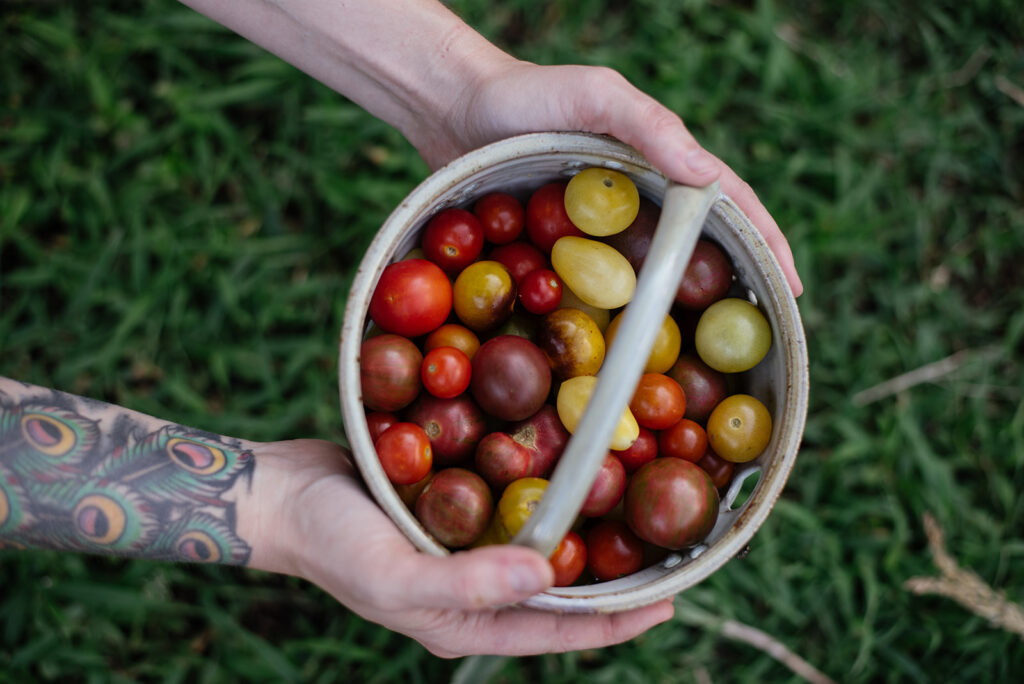There are two main types of tomato plants: determinate and indeterminate. I often get asked how to tell if a variety is a determinate or an indeterminate tomato, what types of tomatoes are indeterminate, and should you prune them? Let me clear up the confusion around these gardening terms and I’ll share some tomato tips and a few tomato recipe ideas.

Why I Grow My Own Tomatoes
I love tomatoes! Tomatoes are my favorite thing to grow in the garden and I grow a lot of them every year. Read here for my best tomato planting tips.
I have grown as many as 115 varieties of tomatoes in my garden in a year. Tomatoes come in a lot of different varieties from slicers to pastes, to cherry tomatoes and we enjoy them all (for more info on the differences of these varieties, check out my post on my must-grow heirloom list).
There are many wonderful varieties of tomatoes that I grow at home that we could never experience if we only purchased tomatoes from a grocery store.

What Are Indeterminate Tomatoes
An indeterminate tomato is a vining variety that essentially will keep growing and growing and growing.
This type of tomato will need some kind of support like a trellis. Here is an article about the trellising methods we use.
Indeterminate tomatoes will keep growing and keep producing more flowers and more fruit if you continue to provide it with the nutrition and the support that it needs. It is called indeterminate because the amount it will grow and produce is undetermined or unknown.
Most tomato varieties are indeterminate. Some examples of heirloom indeterminate tomatoes are Kellogg’s Breakfast, Paul Robeson, Napa Chardonnay Blush Cherry, and the Pink Oxheart.

What Are Determinate Tomatoes
A determinate tomato (sometimes called a dwarf) is a bush variety that grows to a certain height, produces a certain amount of flowers and therefore a certain amount of fruit and then it is done. It will not produce anymore.
Determinate tomatoes have a shorter season, usually around one month, but can produce a bountiful harvest in that time.
While your determinate tomato will not need a trellis to climb, it may still need the support of stakes or a cage when it is loaded with fruit. Determinate tomatoes can be a good choice for containers or if you have limited space.
You can watch my video where I discuss determinate and indeterminate varieties starting at minute 4:27.
How To Tell If a Tomato Is Determinate or Indeterminate
Unfortunately, some seed catalogs and packets do not list whether a tomato variety is determinate or indeterminate which leaves people wondering.
Color is not a good indicator of which type you have because both determinate and indeterminate tomatoes can be red, yellow, orange, purple, and more.
Just know that most varieties of tomatoes are indeterminate varieties unless otherwise specified.
If you're buying tomato starts, the determinate tomato plants will be bushier and usually have leaves closer together, which adds to the bushy look.
If you are still unsure about what type your tomato is, try searching for the information on the web. You can usually find the answers you need.
Caring For Your Tomatoes
If you are new to the wonderful adventure of growing tomatoes yourself, you’ll want to read my post on how to plant tomatoes the best way as well as how to prune tomato plants (it's different depending on the variety).
It is also important to know how long your growing season is when you are growing tomatoes. If you're new to gardening, I highly recommend my course Growing Gardeners that I created with Jill from Whispering Willow Farm. You'll learn all the basics to need to start growing a beautiful and productive garden in just six short weeks. I'll also teach you how to tell the length of your growing season.
Seed packages should tell you how many days a tomato variety needs to reach maturity. Using that information and knowing your growing season length gives you an idea if that plant will be able to come to maturity and produce a harvest before your growing season ends.
Tip: Tomatoes are commonly started indoors or in a greenhouse and then transplanted into the garden, so it is important to know they are counting the days to ripe fruit from when you transplant it into the ground, not from the day it is started. It is generally assumed these will be started for 6 weeks before planting. So plan for 6 weeks to start and then the number of days listed.
Sometimes seed companies will not list how many days to maturity. Here is my rule of thumb for tomatoes: about 55 to 60 days for cherry tomato varieties, 60 days for early tomatoes, and 80 days for large slicers.

Our Tomato Favorites
Tomato sandwiches are a favorite in our home. It feels almost silly to share a recipe because it's about as basic as it gets, but if you have never had a tomato sandwich, you just need to try it! Here’s a short video on how to make a tomato sandwich.
If you have a lot of tomatoes, consider making tomato salsa or dehydrating them. Dehydrated cherry tomatoes are great in salads, on pizza, or added in sauces.
I hope that this was helpful and encouraged you that you CAN grow tomatoes. You just need to start.
More Posts For Tomato Lovers
- Starting Seeds Indoors in 6 Easy Steps (+ Tips for Success)
- A Complete Guide to Seed Saving
- How to Get Rid Of Tomato Hornworms Naturally
- Best Methods For Successful Pure Pollination When Saving Seeds
- My Must Grow Heirloom Seed Variety List
- Where to Buy Heirloom Seeds
- How to Plant Tomatoes the Best Way
- How to Build a Garden Arch Trellis or Garden Arbor (for $30!)
















